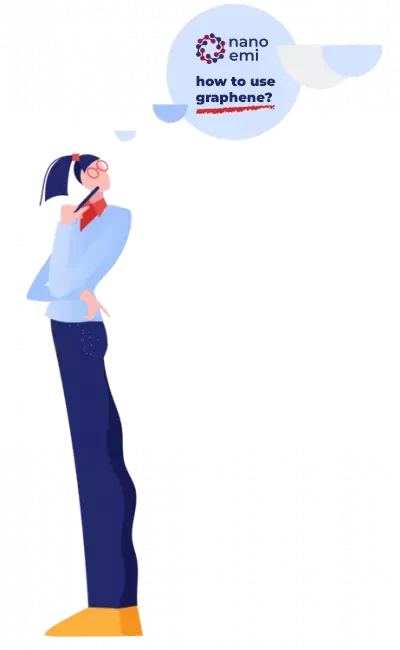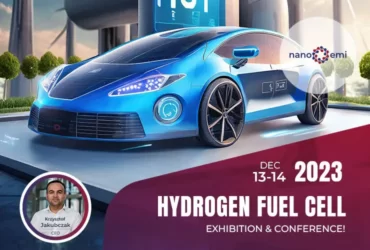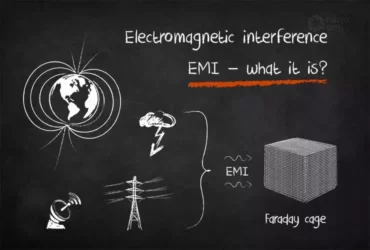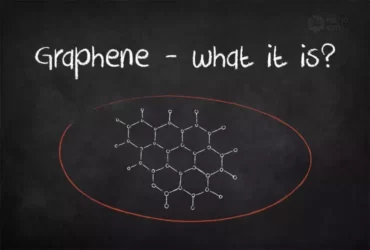
ELECTRONICS


INTERNET OF THINGS

Graphene in Medicine

SMART CITY

NanoEmi - New opportunities. New Graphene 2D materials & composites
NanoEmi is a deep-tech graphene company focused on development of the new 2D materials & composites for efficient screening of electromagnetic radiation. NanoEMI is a startup targeted to solve problem of electromagnetic interference (EMI) or electromagnetic compatibility (EMC) of devices.
We are also a European producer of pure graphene in the form of powdered graphene flakes and a suspension of graphene flakes.
We are European producer of:
Graphene flakes powder
Graphene nanoplatelets in the form of graphene flakes powder. Unleash the power of innovation with our top-notch graphene flakes powder production for next-gen technologies.
Graphene flakes suspension
Full potential of graphene with our high-quality graphene flakes suspension, produced to the highest standards for maximum performance
Emigraph - Composite sheets
Composites that block electromagnetic radiation.
Experience the power of innovation with our Emigraph composite sheets production with shielding solutions, made with the revolutionary graphene material.
R&D
Research and development is the core business of our company. We offer our services in the field of engineering 2D materials with parameters tailored to specific needs.
Our materials are simple in use but highly advanced inside. We employ results of patent-protected nanotechnology achievements of our team.

High conductivity


Graphene properties
- advantages of graphene
Graphene is a two-dimensional material made of a single layer of carbon atoms arranged in a hexagonal lattice pattern. It has several unique properties that make it attractive for various applications in industries such as electronics, energy, and nanotechnology. These properties include high electrical and thermal conductivity, high strength and stiffness, minimal thickness and mass, transparency, and excellent barrier properties. Additionally, graphene has a high surface area, which makes it useful in catalytic reactions and energy storage applications. The combination of these properties makes graphene a promising material for the development of new technologies and products.
High electrical conductivity
Graphene has excellent electrical conductivity, which makes it useful in a wide range of electronic applications.
Minimum thickness of graphene
Graphene is a 2D material that is just one atom thick, which makes it incredibly thin and lightweight.
High mechanical strength
Despite its thinness, graphene is incredibly strong, with a tensile strength that is 100 times greater than steel.
Transparent properties
Graphene is also highly transparent, with a transparency of up to 97.7%, making it useful in applications such as touchscreens,...
Thermal conductivity of graphene
Graphene is also an excellent thermal conductor, which makes it useful in applications that require heat dissipation.
Minimum mass of graphene
Minimum mass is one of the key of graphene mechanical properties
Stable strong sp2 bonds
Stable strong sp2 bonds is one of the key of graphene chemical properties
Perfect thermal conductor
Perfect conductor is one of the key of graphene thermal properties
Streatchable properties
Graphene is highly flexible and can be bent, twisted, or folded without losing its strength or properties.
Interfaced with molecules and cells
Interfaced with molecules and cells is one of the key of graphene mechanical properties
Graphene high carrier mobility
One of the properties of graphene is the high mobility of carriers
Graphene applications
Get access to the most advanced technology and expertise when you choose us. Experience the limitless potential of graphene technology with our diverse range of applications, from energy storage to flexible electronics.
Transform the world with our innovative graphene solutions, designed to revolutionize industries and improve lives.
Unlock the full potential of graphene with our cutting-edge technology applications.
Join forces with a team that is dedicated to delivering innovative solutions to meet your needs. Revolutionize your industry with graphene solutions designed to meet your unique needs. Experience the limitless possibilities of graphene and its transformative impact on your business.
We lead the way to progress
with a talented scientist team by our side
We have a team of qualified scientists on our side who successfully face graphene challenges. We are the owners of patented technologies, we find new solutions for various industries, driving their development.
Specialists in 2D materials
Revolutionize your industry with our top-of-the-line graphene 2D materials.
Our company has advanced production facilities using state-of-the-art technology to produce high-quality graphene with exceptional precision and repeatability.
Nanoemi's team of experts can customize graphene production to meet your specific needs, in a wide range of graphene sheet layers.
Pure graphene is characterized by its superior electrical, thermal, and mechanical properties, making it an ideal material for a wide range of applications, from advanced electronics to aerospace engineering.
Join the forefront of innovation with our high-quality graphene 2D materials. Contact us today to learn more about how we can help elevate your research and development.


NanoEmi is a graphene nanocomposites producer
Get on the train with the most advanced nanocomposites produced from graphene flakes
The most advanced nanocomposites produced from graphene flakes are materials that combine graphene, a single layer of carbon atoms arranged in a hexagonal lattice, with other materials to create a strong, lightweight, and highly conductive material. Graphene flakes are dispersed in a matrix material to create a composite that has unique properties such as high strength, stiffness, electrical conductivity and emi shields.
nanoEMI produces composites that block electromagnetic radiation
EMI has to be addressed by both proper electronics design and shielding to assure electromagnetic compatibility (EMC). EMC essentially means that the device meets some specific legal requirements limiting the amount of electromagnetic energy that the electronics is allowed to emit into the ambience. NanoEMI produces composites that block electromagnetic radiation thus work as shields for broad range of frequencies.
Reduction of mass
By combining graphene with other materials, such as polymers, metals or ceramics, it is possible to produce composites that are significantly lighter than conventional materials without compromising on their strength or stiffness.




Frequently asked questions about graphene
Discover the answers to commonly asked questions about graphene, empowering you with knowledge about this revolutionary material.
Graphene is considered a “Polish miracle of technology” because of the pioneering work of Polish scientists in the field of graphene research. The term “Polish miracle” refers to the achievement of Polish researchers in the discovery and characterization of graphene, which is considered one of the most important discoveries in modern science.
In 2004, Andre Geim and Konstantin Novoselov, two researchers at the University of Manchester, were the first to isolate and study a single layer of carbon atoms, which they named graphene. However, Polish scientists, namely scientists from the Institute of Physics of the Polish Academy of Sciences (IFPAN) in Warsaw, were among the first to demonstrate the potential of graphene for practical applications.
In 2010, a team of scientists at IFPAN, led by Prof. Marek Potemski, published a groundbreaking paper that demonstrated the potential of graphene for use in high-speed electronics. The team was able to demonstrate that graphene can be used to create high-speed transistors, which could potentially lead to the development of faster and more energy-efficient electronics.
Furthermore, Polish scientists are actively working on developing industrial applications of graphene. In 2013, a team at the Polish Academy of Sciences Institute of Physics, led by Prof. Piotr Kula, developed a new method for the large-scale production of graphene, which has the potential to significantly reduce the cost of producing graphene. This could make it possible to produce graphene-based products on an industrial scale, which could lead to the commercialization of graphene-based products.
In addition, Polish scientists are also actively involved in international research collaborations that aim to further the development of new technologies based on graphene. The Polish Academy of Sciences is also involved in the European Union’s Graphene Flagship program, which is one of the largest research initiatives in Europe, aimed at developing new technologies based on graphene.
In summary, Polish scientists have made significant contributions to the field of graphene research, from the discovery and characterization of graphene to the development of new methods for its production and the demonstration of its potential for practical applications. This pioneering work in graphene research has earned Poland a reputation as a leader in the field of graphene technology and has led to the term “Polish miracle of technology” being associated with graphene.
Yes, Poland produces graphene. The country has a strong research and development sector in the field of graphene, with several research institutions and universities actively working on the development of new technologies based on graphene. Additionally, there are several companies in Poland that are involved in the production and commercialization of graphene-based products.
One example is Graphene Labs, a Polish-based company that specializes in the production and commercialization of graphene-based materials and products. The company produces graphene powders, graphene sheets, and graphene-based composites, which are used in a variety of applications, including energy storage, electronics, and biomedical engineering.
Another example is Graphene Industries, a Polish company that focuses on the production and commercialization of graphene and other 2D materials. The company is actively working on developing new technologies and products based on graphene, such as supercapacitors, sensors, and coatings.
Polish scientists have also developed new methods for large-scale production of graphene which could make it possible to produce graphene-based products on an industrial scale, which could lead to the commercialization of graphene-based products. The Polish Academy of Sciences is also involved in the European Union’s Graphene Flagship program, which is one of the largest research initiatives in Europe, aimed at developing new technologies based on graphene.
In summary, Poland has a strong research and development sector in the field of graphene and a growing number of companies that are involved in the production and commercialization of graphene-based products. The country’s expertise in the field has led to the term “Polish miracle of technology” being associated with graphene.
Graphene is so hard to produce because of its unique atomic structure and properties. Graphene is a single layer of carbon atoms arranged in a hexagonal lattice, making it the thinnest material known to exist. Its remarkable properties, such as high strength, flexibility, and electrical conductivity, make it a highly desirable material for a wide range of applications, including electronics, energy, and aerospace.
However, the process of producing graphene is difficult and expensive. Traditional methods involve the use of harsh chemicals, high temperatures, and specialized equipment, making it challenging to produce large quantities of high-quality graphene. Additionally, the production process requires precise control over the size and shape of the graphene sheets, which can be difficult to achieve consistently.
Despite these challenges, nanoEMI’s researchers are constantly exploring new methods for producing graphene more efficiently and cost-effectively. As the technology continues to improve, it is likely that graphene will become more widely available and increasingly integrated into a variety of products and applications.
Graphene can be made using several methods, each with its advantages and disadvantages. Some of the most commonly used methods are:
Chemical Vapor Deposition (CVD): This is the most widely used method for producing high-quality, single layer and large area graphene. It involves heating a carbon-containing gas (such as methane or acetylene) in the presence of a substrate (such as copper) at high temperatures. The carbon atoms then settle on the substrate and form a graphene layer.
Graphite exfoliation: In this method, graphite (a layered material made up of multiple sheets of graphene) is chemically treated to remove the layers of graphene from the surface. The resulting graphene flakes are then dispersed in a solvent to create a graphene solution.
Epitaxial Growth: This method involves growing graphene on a substrate that has a similar crystal structure to graphene. The graphene layer is then transferred to a target substrate using a transfer method.
Chemical Reduction of Graphene Oxide: Graphene oxide is a form of graphene that is easier to produce but has lower quality. It is made by oxidizing graphite, and then the graphene oxide is reduced chemically to obtain graphene.
These are some of the most commonly used methods for producing graphene, each with its advantages and disadvantages depending on the desired application. As the technology continues to improve, researchers are exploring new methods for producing graphene more efficiently and cost-effectively.
Graphene products are made by a variety of companies and organizations that specialize in the production and commercialization of graphene materials. Many of these companies have extensive expertise and access to specialized equipment for producing high-quality graphene.
The leading companies have invested in state-of-the-art equipment, such as Chemical Vapor Deposition (CVD) reactors, to produce high-quality graphene at scale.
In addition to these companies, there are also many academic and research institutions that have expertise in the production and characterization of graphene materials. These organizations often have access to specialized equipment for synthesizing and analyzing graphene, such as Transmission Electron Microscopes (TEM) and Raman Spectroscopes.
The production of high-quality graphene requires significant expertise and specialized equipment, which is why many of the leading companies in the industry have invested heavily in research and development to improve their production methods and scale up their operations. As the technology continues to develop and more companies enter the market, it is likely that we will see even more advances in the production of graphene and its commercial applications.
Graphene flakes powder refers to a form of graphene that consists of small, randomly oriented flakes of graphene. These flakes can vary in size and shape, and are typically produced using various methods such as liquid-phase exfoliation or chemical vapor deposition.
Graphene flakes powder has many unique properties that make it attractive for various applications. For example, its large surface area and high aspect ratio make it an excellent candidate for use in composites, coatings, and sensors. In addition, its high electrical conductivity and thermal conductivity make it suitable for use in electronic devices and thermal management applications.
Graphene flakes powder can be easily dispersed in a variety of solvents to form stable suspensions, which can then be used for various applications. The flakes can also be functionalized with different molecules to modify their properties and tailor them for specific applications.
The graphene flakes powder is a versatile material with many potential applications in various fields, including electronics, energy, and biomedicine.
Nanoemi specializes in the production of graphene flakes powder.
Graphene was first isolated and characterized by Andre Geim and Konstantin Novoselov, who were professors at the University of Manchester in the United Kingdom. They published their discovery in 2004 in the journal Science. Their work was based on previous research on carbon nanotubes and fullerenes, but they were able to isolate and study individual graphene sheets for the first time.
Geim and Novoselov’s discovery of graphene was considered a breakthrough in the field of materials science and earned them the 2010 Nobel Prize in Physics. Their method of isolating graphene, known as mechanical exfoliation, is still widely used today.
It’s important to note that graphene, a one-atom-thick planar sheet of sp2-bonded carbon atoms that are densely packed in a honeycomb crystal lattice, had been theoretically predicted and studied for decades before being isolated and studied by Geim and Novoselov.
Graphene is an incredibly versatile material that has a wide range of potential applications. Some of the most promising uses for graphene include:
Electronics: Graphene’s high electric conductivity and high carrier mobility make it a promising material for electronic devices such as transistors, sensors, and touch screens.
Energy storage: Graphene’s high surface area and excellent conductivity make it an ideal material for batteries and supercapacitors.
Composites: Graphene can be added to other materials to improve their strength and conductivity. This makes it useful in applications such as aircraft parts and sporting goods.
Biomedical: Graphene is biocompatible and can be used in medical applications such as sensors, drug delivery, and tissue engineering.
Catalysis: Graphene’s high surface area and excellent conductivity make it a promising material for catalytic applications in chemical reactions and energy conversion.
Water filtration: Graphene’s high surface area and chemical stability make it a good candidate for water filtration, including desalination and treatment of industrial waste water.
Photonics and Optoelectronics: Graphene’s unique optical properties make it a promising material for use in optoelectronics, such as in photodetectors, solar cells, and light-emitting diodes.
Thermal management: Graphene’s high thermal conductivity makes it a promising material for thermal management in electronic devices and other applications.
Sensors: Graphene’s excellent electrical and mechanical properties make it a promising material for use in sensors, such as pressure sensors, chemical sensors and biosensors.
Coatings: Graphene’s excellent mechanical, electrical and optical properties make it a promising material for use in coatings, such as in self-cleaning, anti-corrosion, and anti-bacterial coatings.
This list is not exhaustive and there are many more potential applications for graphene being researched and developed. The unique properties of graphene make it a promising material for a wide range of applications in various fields, from electronics to biotechnology.
You can receive your order anywhere in the world as we offer international shipping. We send orders quickly and efficiently to the address provided by the customer during the purchase process, in accordance with our delivery price list which outlines the shipping costs for various countries and regions. So no matter where you are, you can receive your order straight to your desired company address.
Absolutely, we ship orders worldwide and the delivery country can indeed be different from the purchase country. We have a delivery price list that outlines the shipping costs for various countries and regions, so customers can choose their preferred delivery option based on their location.
Graphene is a highly versatile material that has potential applications in a wide range of products across various industries. Some examples of products that currently contain or have the potential to contain graphene include:
Electronics: Graphene-based transistors, batteries, and touchscreens are being developed for use in smartphones, tablets, and other electronic devices.
Energy: Graphene-based solar panels, supercapacitors, and batteries have the potential to improve the efficiency and storage capacity of renewable energy systems.
Aerospace: Graphene is being studied for use in lightweight and high-strength composite materials for aircraft and spacecraft.
Healthcare: Graphene-based biosensors and drug delivery systems are being developed for medical applications such as disease detection and drug delivery.
Sporting goods: Graphene-based materials are being used in tennis rackets, bicycles, and other sports equipment to improve strength, durability, and performance.
Automotive: Graphene-based materials are being explored for use in tires, paints, and composites to improve fuel efficiency and reduce emissions.
Construction: Graphene-based materials are being researched for use in concrete, coatings, and insulation to improve strength, durability, and energy efficiency.
These are just a few examples of the many potential applications for graphene. As research into graphene continues, it is likely that new products and applications will be discovered.
Graphene is an extremely flexible material, due to its two-dimensional structure and the weak van der Waals forces between its layers. It can be bent, twisted, and folded without breaking, making it an excellent candidate for flexible electronics, wearable devices, and other applications where flexibility is important.
Studies have shown that graphene can be stretched by up to 25% of its original length without breaking, and can also be compressed to a great extent without losing its mechanical properties. This remarkable flexibility is due to the fact that graphene is just one atom thick, which allows it to conform to the shape of the surface it is placed on.
In addition to its flexibility, graphene also has excellent electrical conductivity and optical transparency, making it a highly attractive material for a wide range of applications, including flexible electronics, sensors, and energy storage devices.
However, the temperature at which graphene can withstand varies depending on the specific application and the conditions it is exposed to. In some cases, graphene may begin to degrade or break down at lower temperatures, particularly if it is exposed to environmental factors such as oxygen or humidity.
Graphene’s high thermal conductivity and ability to withstand high temperatures make it a promising material for a wide range of applications, particularly in the field of thermal management.
Latest graphene posts. Don’t miss it.

NanoEMI at the HYDROGEN FUEL CELL 2023 exhibition and conference

Electromagnetic interference – EMI – what it is?

Graphene – what it is?
Subscribe to newsletter & get company news.



















